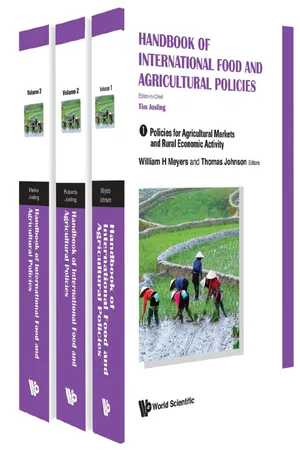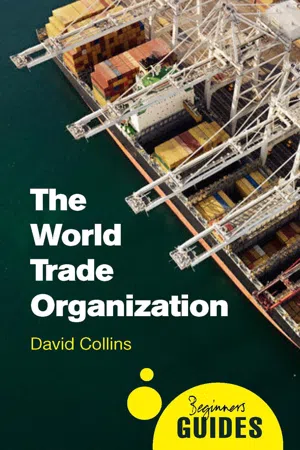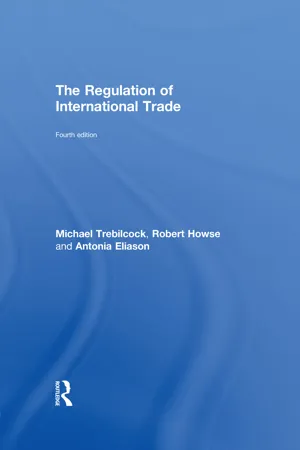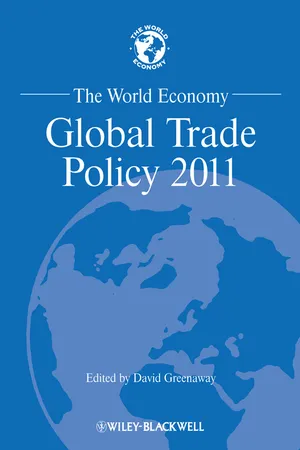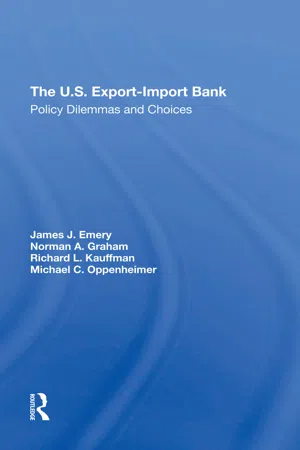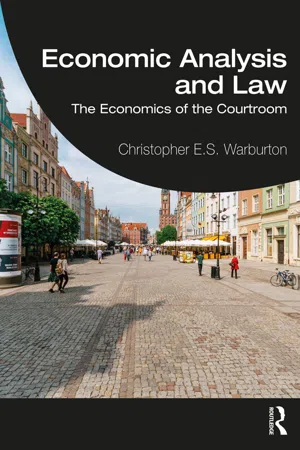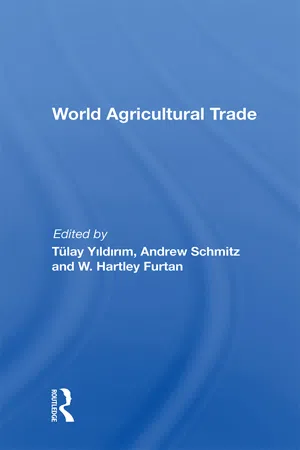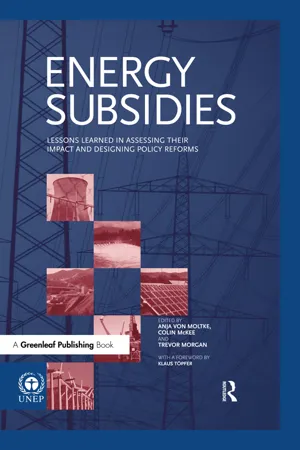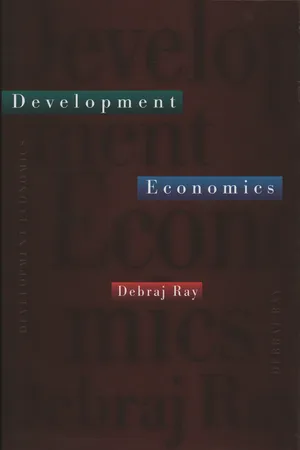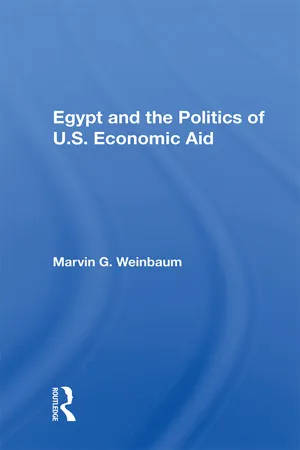Economics
Export Subsidies
Export subsidies are financial incentives provided by governments to domestic companies to encourage them to export goods. These subsidies can take the form of direct payments, tax breaks, or other financial assistance. The goal is to make the country's exports more competitive in the global market by reducing the cost of production and increasing the volume of exports.
Written by Perlego with AI-assistance
Related key terms
Related key terms
1 of 4
Related key terms
1 of 3
12 Key excerpts on "Export Subsidies"
- eBook - ePub
Handbook of International Food and Agricultural Policies
(In 3 Volumes)Volume 1: Policies for Agricultural Markets and Rural Economic ActivityVolume 2: Policies for Food Safety and Quality, Improved Nutrition, and Food SecurityVolume 3: International Trade Rules for Food and Agricultural Products
- William H Meyers, Thomas Johnson, Donna H Roberts, Karl Meilke(Authors)
- 2017(Publication Date)
- WSPC(Publisher)
While conceptually an export tax is simply a negative subsidy, the disciplines that the WTO applies with respect to these two trade policy instruments are quite different. WTO Members place a high priority on containing and eliminating the use of Export Subsidies. In contrast, WTO rules do not discipline its Members’ application of export taxes even though this is the instrument that relates directly to the exercise of market power in export markets (Lloyd, 2005). In fact, about one-third of WTO Members impose export duties (Piermartini, 2004).Export Subsidies and taxes are both border measures that are conditional upon the product being exported and the agent exporting the product either being subsidized or taxed. Traditionally, more policy and academic attention has been paid to Export Subsidies than to export taxes. However, Croser and Anderson (2011) show that, for the period 2000–2004, export taxes and subsidies contributed almost equally to global agricultural trade distortions. Furthermore, over the 1981–1984 period, Croser and Anderson (2011) demonstrated that on a global basis export taxes were seven times more trade-distorting than Export Subsidies. The reliance on export taxes was reflective of inward looking development policies where developing countries taxed agriculture to promote industrial development (Anderson, 2017). Moreover, a series of commodity price surges beginning in 2007/2008 re-focused concerns about the role that export restrictions played in exacerbating price surges.The WTO takes a broad view of the definition of a subsidy as “a financial contribution by a government or any public body within the territory of a Member that confers a benefit” (WTO, 1999). Given this very broad definition, an export subsidy can include direct payments, the granting of tax relief, the granting of low-interest loans, disposal of government stocks at below-market prices, subsidies financed by producers or processors as a result of government actions, marketing subsidies, transportation and freight subsidies, and subsidies for commodities contingent on their incorporation in exported products (ERS, 2003). Despite a WTO prohibition on subsidies that are contingent on export performance (WTO, 1994a, Article 3), these subsidies until very recently persisted in markets for agricultural products and capital goods. Agricultural Export Subsidies got special attention in the WTO because until now there was no outright prohibition on these subsidies although the Agreement on Agriculture put limits on existing Export Subsidies and prohibited the use of new Export Subsidies. - eBook - ePub
- Leslie A White(Author)
- 2016(Publication Date)
- Routledge(Publisher)
We have reviewed the efforts of the Federal Government of the United States to curb the growth and power of great corporations, on the one hand, and to encourage and support small business enterprise on the other. We now turn to another area of governmental interference in the free enterprise system, namely subsidies.The term subsidy, as it is generally used, refers to assistance, financial or otherwise, rendered an industry by government without equivalent recompense. The assistance may consist of outright payments of money. But tax concessions, price supports, import quotas and other forms of protection against competition, low interest loans, provision of goods and services gratuitously or at less than cost, etc., are commonly regarded as subsidies.Subsidies may be direct or indirect, visible or concealed. In an earlier chapter we noted subsidies paid to grow mulberry trees to feed silk worms; payment was direct and obvious. Airlines and shipping companies have received concealed subsidies by being paid more than cost for transporting the mails. Also, within the Post Office Department, some classes of mail, e.g., magazines of private publishers, are carried at less than cost, while other classes may more than pay their way. The petroleum industry in the United States has been subsidized by “percentage depletion and permission to charge off the bulk of new exploration costs as current expense … [enabling] oil producers to avoid income taxes and accumulate great fortunes” (Bassie, 1968, p. 366). Subsidies increased as tax rates were raised; and when profits were threatened by foreign competition, oil “producer pressures induced the government to establish import quotas—a secondary subsidy to protect the values already established” (Bassie, 1968, p. 366). There has been considerable debate as to whether or not the use of public highways by trucking companies and bus lines in competition with railroads, constitutes a form of subsidy (see Subsidy and Subsidy-Effect Programs - eBook - ePub
The World Trade Organization
A Beginner's Guide
- David Collins(Author)
- 2015(Publication Date)
- Oneworld Publications(Publisher)
The success of tariff negotiations, coupled with the non-discrimination guarantees of most favoured nation and national treatment, accordingly led to new challenges for politicians who wanted to help their own producers. The WTO’s increasing membership sought creative ways to favour their own goods, in conjunction with sticking to GATT rules on tariff bindings and agnosticism with respect to a product’s origin. In particular, the unfair trade practices of subsidization and dumping have now become the most readily used weapons in the arsenal of the trade protectionist. Recognizing the danger of these key policy tools, the WTO realized that it needed to expand its mandate to address these types of trade-distorting practices. Drafted in the 1940s, the GATT rules on subsidies and dumping were inadequate for the modern era, so the WTO created two dedicated agreements to address these highly popular and contentious fields of national economic policy. We will look at both of them in this chapter.Subsidization
If you cannot make foreign products more expensive because tariffs have been essentially eliminated, then why not make domestic ones cheaper? As long as the local product is less expensive than the equivalent foreign one, it doesn’t matter how this is achieved, at least from the perspective of protecting your own producers. This strategy – helping domestic firms keep their costs low so that they can make their products cheaper – is known as subsidization.Assistance granted by national governments to make certain sectors or companies more competitive than they are in reality operates as a market distortion. In that sense, it is as bad as a tariff. In some ways it is even worse because, unlike a tariff, a subsidy does not generate revenue for the government, it actually consumes it. This is one of the reasons that economists tend to agree that subsidies are generally inefficient and should not be used as tools of economic policy. Yet their use persists throughout the world. One possible justification for the use of subsidies is that they generate so-called ‘positive externalities’, meaning additional beneficial consequences beyond simply helping the target company or industry, many of which can be difficult to quantify. These can include increased employment, regional regeneration and improvements to the general social welfare. Some of these may not have any trade-distortive effects.Of course, resistance to government assistance in the economy can be seen as a liberal Western, market-oriented conception of what constitutes the proper sphere of governmental involvement. Countries with a tradition of governmental supervision of the economy, such as that practised by the countries of the former Soviet Union, as well as (to a degree) China today, may not see anything wrong with what we would call subsidization. Indeed, there are a number of very significant state-owned enterprises in Russia and China, as well as in Latin America, where there is a similarly strong tradition of state interventionism in the economy. Companies get help from governments all the time in these places. In fact, involvement in commercial activities is very much what governments do. Where there is no clear demarcation between the government and the private entity, it is very difficult to ascertain whether or not a subsidy can be said to exist. - eBook - ePub
The Regulation of International Trade
4th Edition
- Robert Howse, Antonia Eliason(Authors)
- 2013(Publication Date)
- Routledge(Publisher)
283 While we recognize the broader international risk of Prisoner’s Dilemma-type export subsidy wars, negotiated reductions of, or restrictions on, such subsidies in given contexts, as reflected in the Uruguay Round Agreement on Agriculture, the Tokyo Round Code on Trade in Civil Aircraft, and the OECD Agreement on Civil Shipbuilding and Repair, seem an appropriate response to this problem. We also recognize that pure Export Subsidies will typically be harder to justify in terms of non-trade-related domestic policy objectives, most of which can be better served by subsidies or other policy instruments that are not targeted exclusively on exports, but again it is not clear why this should be of concern to the importing country.Similarly, generally available subsidies under the Uruguay Round Agreement are not seen as trade distorting with respect to either imports or exports, presumably because they do not disproportionately influence the price of particular categories of goods. However, this view reflects a rather static conception of comparative advantage; most modern international trade theorists believe comparative advantage is a dynamic concept and is not entirely exogenously determined.284 Clearly, many developed countries owe a significant part of their international comparative advantage to social investments in health, education, law and order, basic research, and physical infrastructure. It may be the case that generally available subsidies are more benign than selective subsidies because they are less likely to be the product of rent seeking by special interest groups. It may also be the case that generally available subsidies are reflected more fully in exchange rate adjustments than selective or targeted subsidies. However, in an international environment, where exchange rates are determined increasingly by international capital flows rather than goods flows, it is not clear how robust this assumption is, or when one can be confident that generally available subsidies have induced appropriate exchange rate adjustments while more selective subsidies have not.Finally, there remain selective domestic subsidies with export spillovers. In this case, the economic analysis is the same as that for the case of pure Export Subsidies: the importing country receives lower-priced goods and increases its welfare. To the extent that such subsidies squeeze out a third-country’s exports, then the third country should, as in the case of pure Export Subsidies, have a right to bring a nullification and impairment claim before a GATT dispute resolution panel. - eBook - ePub
The World Economy
Global Trade Policy 2011
- David Greenaway, David Greenaway(Authors)
- 2012(Publication Date)
- Wiley-Blackwell(Publisher)
2The northeast Asian developing economies, for instance, were able to pursue active export promotion especially until the 1980s. The measures taken comprised tax incentives (Falvey and Gemmell, 1990), duty drawback (Wade, 1991), export credit/insurance (Mah and Milner, 2005), provision of export processing zones (EPZs) or special economic zones (Warr, 1990; Mah, 2008), devaluation or depreciation of domestic currency and establishment of export promotion organisations providing trade marketing, information and assisting trade fair (Seringhaus and Rosson, 1990). Until the early 1990s, developing countries were relatively free from trade regulations in the global trading system prohibiting the use of export promotion measures. Meanwhile, as of now, there are many restrictions or even strict prohibition on the developing countries’ use of export promotion policies under the WTO system. Considering the different levels of economic development between developed and developing countries, one may wonder whether or not the current WTO system, which strictly regulates the use of export promotion policies by developing countries, is ‘fair’.This paper explains the export promotion measures that can be utilised by developing countries under the current WTO system and compares the WTO Members’ proposals on modification of export promotion provisions in the Doha Development Agenda (DDA) negotiations. Then, from the viewpoint of ‘distributional fairness’, it suggests ways of modifying the special and differential treatment (SDT) provisions applied to exports of developing economies in the Agreement on Subsidies and Countervailing Measures, the Subsidies Code hereafter, of the WTO. Despite the importance of export promotion in economic development, there has been little, if any, work focusing on the SDT of developing countries with respect to export promotion policies in the WTO system. This paper is intended to fill that gap. - Conor Quigley(Author)
- 2022(Publication Date)
- Hart Publishing(Publisher)
Part V FOREIGN AND UK SUBSIDY CONTROLPassage contains an image Chapter Twenty-one SUBSIDY CONTROL AND THIRD COUNTRIES
21.1 SUBSIDY CONTROL AND INTERNATIONAL AGREEMENTSWTO Agreement on Subsidies and Countervailing Measures European State aid law applies only as respects subsidies granted by Member States that affect trade within the EU or the EEA. For international trade, the principal agreement is to be found in the rules of the World Trade Organisation.1 These include the Agreement on Subsidies and Countervailing Measures (SCM) which was incorporated into EU law by Council Regulation (EC) No 3284/94 on protection against subsidised imports from countries not members of the European Union.2 A countervailing duty may be imposed for the purpose of offsetting any subsidy granted, directly or indirectly, for the manufacture, production, export or transport of any product whose release for free circulation in the EU causes injury. The SCM applies only to subsidies for goods. The equivalent agreement on trade in services, GATS, contains no provision on subsidies. Specific provisions deal with trade in agricultural products, excluding fisheries.A subsidy is defined as a financial contribution by a government or any public body whereby a benefit is conferred. A financial contribution arises in the following cases:3(a) a direct transfer of funds (grants, loans, contribution of capital); potential transfer of funds or liabilities (guarantees); (b) government revenue that is other wise due is foregone or not collected (e.g. fiscal incentives such as tax credits) (c) provision of goods or services other than general infrastructure; (d) payments to a funding mechanism or direction of a private body to carry out a function falling with (a) to (c) above. Conferral of a benefit on the recipient of the financial contribution arises where it is made on terms more favourable that those available in the market. It follows that a benefit occurs where the recipient is placed in a better financial position than it would have been in the absence of the measure in question. A benefit will not be considered as being conferred in the following circumstances:- eBook - ePub
The U.s. Exportimport Bank
Policy Dilemmas And Choices
- James J. Emery, Michael F Oppenheimer, Norman A Graham, Richard L Kauffman(Authors)
- 2019(Publication Date)
- Routledge(Publisher)
Eximbank finance is an important factor in support of high-technology exports because of the use of credit subsidies by competitors to support their high-technology industries. The Bank's role is in offsetting these credit subsidies, as in other industries. The Bank would be an inefficient means of attempting to offset the effects of extensive government support of high-technology industries by other industrial nations. If additional government intervention is necessary in this regard it would be better directed at the source of technological advancement through greater incentives for innovation and increasing research and development effort.Government Intervention in Support of Exports
As the preceding discussion of high-technology industries illustrates, U.S. capital goods producers are often faced with competition from foreign industries that receive extensive governmental backing. Where government support takes the form of outright subsidy (except export credits), overly restrictive government procurement preferences, and other blatantly protectionist means, some form of remedy is generally available through provisions of the U.S. Trade Acts or the MTN codes. However, government support often takes less tangible or easily countered forms. A particular problem U.S. firms face from European industry is that of competition from state-owned enterprises. This is especially true in aircraft and aircraft engines, nuclear power, and telecommunications. State-owned enterprises are typically not under the same type of pressure to produce continual profits as is private industry in the United States, and typically respond more to the goals of increasing production and employment. They are in many cases more willing to take loss-leading ventures into new markets than their U.S. counterparts are.While state-owned firms typically enjoy a variety of government supports, they also share these with private firms that are the favored targets of industrial policies. The use of negotiating leverage by high-level government officials and a willingness to introduce diplomatic concessions into commercial negotiations are perhaps the most distortive of these measures. One example of the extreme use of these types of linkages was the tying of aircraft sales to the granting of reciprocal landing rights. The recognition of the distortive effects of these practices led to the civil aircraft agreement concluded in the Tokyo Round of multilateral trade negotiations. In general, the United States has been more reticent than competitors to utilize such means of export promotion. For example, high-level visits by U.S. officials to foreign countries are rarely accompanied by commercial representatives of U.S. firms, which is a standard practice of other industrial nations. - eBook - ePub
Economic Analysis and Law
The Economics of the Courtroom
- Christopher E.S. Warburton(Author)
- 2020(Publication Date)
- Routledge(Publisher)
45While multiple negotiations between the US and the EC were conducted in the 1990s, the concept of subsidy was multilaterally imprecise until one was provided by the SCM Agreement during the Uruguay Round of talks:A subsidy exists where―there is a financial contribution by a government, and―a benefit is thereby conferred. Financial contribution is broadly construed as meaning―money or anything else of value provided to a manufacturer or exporter at a cost less than would have been charged in a commercial transaction. This includes measures such as exchange rate guarantees, debt forgiveness, export credits, and equity infusions, and any capital or development supports provided on terms more favorable than terms available from commercial lenders. In addition, this can also include indirect support such as benefits from government or defense contracts.(Kienstra, 2012, p. 583)Newer agreements meant newer negotiating framework and contending reference points, which further complicated negotiations. While the Uruguay Round, as it was signed on December 15, 1994, did not include a new agreement on civil aircraft, the SCM Agreement and the DSU included the LCA industry.In the SCM Agreement, subsidies fall into three broad classifications: (i) permissible, (ii) actionable, and (iii) prohibited; the so-called “green, yellow, and red lights.” Contingent subsidies (in law or fact) are prohibited subsidies. Prohibited subsidies are based on prospective export performance and are intended to give firms a competitive edge while also increasing their revenue base. Actionable (specific) subsidies cause adverse effects on free trade (see Figure 8.8 Panel (b)). Specific subsidies are injurious; they cause nullification and create serious prejudice to the interests of other Members. Serious prejudice occurs when a subsidy displaces or impedes imports into the subsidizing country or a third country market. The subsidy must also cause significant price undercutting, suppression, depression, or increase the world market share of the subsidizing country that causes loss to others.46 - eBook - ePub
- Andrew Schmitz(Author)
- 2019(Publication Date)
- Routledge(Publisher)
An important difference between the export-subsidy policy and the marketing-board policy is the source of funds that are transferred to producers. This implies important differences in the incidence of costs and benefits of producer-price support between the policies. The export subsidy involves taxpayers' funds and, if these funds were to have a large enough marginal excess burden, the export subsidy could be a less efficient way of supporting producers. If the deadweight losses from general taxation were absent, the export subsidy would clearly be more efficient than the marketing board. If a marketing board were to achieve the same benefit for producers, it would have to raise revenue from its consumers.When price discrimination among foreign markets is not possible, and domestic demand is less elastic than foreign demand, the marketing board will tax domestic consumers more heavily so that exports will be subsidized at a greater rate, on average, compared with the explicit export subsidy. In turn, the burden on third-country exporters is greater from the marketing board than from the pure-export subsidy Relative to the marketing board, the transfer efficiency of Export Subsidies could be higher or lower in terms of benefits to producers per dollar of harm to domestic consumers and taxpayers, but it could not be lower in terms of benefits to producers per dollar of harm to third countries. At first, this new result seems somewhat surprising but, on closer examination, the countries with wheat-marketing boards (Australia, Canada and, in the past, Argentina) have tended to offer lower rates of producer protection than the countries that used explicit Export Subsidies (notably the United States and the European Union). This may have masked the fact that, for a given rate of protection to producers, the marketing board required a higher effective rate of export subsidy.Generally, when price discrimination among international markets is possible, the effects are more ambiguous. The extent to which domestic price discrimination can be used to achieve a particular support level is a function of the relative elasticities and the size of the various markets. It was shown in our simulation results that, compared with targeted Export Subsidies (and even more so compared with flat Export Subsidies), the CWB is a more efficient mechanism for supporting Canadian wheat producers. - eBook - ePub
Energy Subsidies
Lessons Learned in Assessing their Impact and Designing Policy Reforms
- Anja von Moltke, Colin McKee, Trevor Morgan, Klaus Töpfer(Authors)
- 2017(Publication Date)
- Routledge(Publisher)
Direct subsidies, in the form of grants or tax exemptions, act as a drain on government finances. For example, the IMF estimates that the Iranian government’s direct spending on energy subsidies amounted to $4 billion in 1997—8% of its budget. The cost of oil product subsidies in Indonesia is even higher, at around 10% of central government spending. The special low rate of VAT that was applied to the sale of electricity and gas to households by the Czech and Slovak governments in the 1990s exacerbated those countries’ budget deficit problems. Direct subsidies on oil products can lead to acute pressure on government finances during periods of rising prices. This has been a major problem in several developing countries, including Indonesia. Indonesia allocated almost $4 billion to oil subsidies in 2002. If left unchanged, the bill for those subsidies would soar to around $36 billion between 2000 and 2005 due to higher oil prices. In the long run, indirect subsidies that reduce economic growth also lead to lower government tax revenues.Subsidies always have an impact on international trade. Consumption subsidies that increase energy use boost demand for imports or reduce the amount of energy available for export. This harms the balance of payments by increasing the country’s dependence on imports. For example, the massive increase in LPG use in Senegal that resulted largely from subsidies has led to a huge increase in imports. The Indonesian government estimates that energy subsidies in total will cost the country $16 billion in lost export earnings over the five years to 2005 if they are left as they are. Iran’s exports of crude oil will decline rapidly if subsidies are not removed soon, since production will be unable to keep pace with soaring domestic consumption. Subsidies in major energy-producing countries such as Indonesia and Iran also undermine global energy security to the extent that they reduce those countries’ capacity to export. The removal of subsidies to oil products would lower domestic demand in Indonesia and free up more oil for export, thereby reducing the share of the dominant OPEC countries in international oil trade and reducing those countries’ ability to push for higher prices. - eBook - ePub
- Debraj Ray(Author)
- 1998(Publication Date)
- Princeton University Press(Publisher)
An export promotion strategy essentially is a mirror image of an import substitution policy. In contrast to tariffs and quotas on imports, exports are subsidized in several ways. Here are some of the basic features of an export promotion policy.Targeted nonprimary exports
Export promotion generally comprises the encouragement of various types of manufactured products that range from light manufactures, such as footwear and textiles, all the way to more sophisticated items, such as automobiles or memory modules for computers. It is rarely, if ever, the case that the export of primary products is encouraged by governments of developing countries. For one thing, most developing countries possess a comparative advantage in such products and there is nothing in particular to encourage! More to the point, countries that seek to reverse or transform the pattern of trade have traditionally viewed their dependence on primary exports as inimical to progress.Reduced import duties, or import quotas for exporters
One of the main ways in which exports are promoted is by making the imported materials needed for their manufacture relatively easy to obtain. This is done by preferential duty treatment of imports that can be shown to be needed for the manufacture of items that are to be exported. Thus in an overall regime with tariffs or quotas on imports, exporters are often permitted to obtain needed imports at lower rates.Preferential credit
An export promotion strategy often recognizes that the lack of plentiful credit can impede expansion and innovation. Therefore banks are often directed to provide credit on easier terms to those firms who export their products. These subsidies may be provided either in the form of a lower interest rate on loans or a larger loan size.17.3.2. Effect on the exchange rate
The instruments of export promotion work very much like an import substitution policy in reverse. Note, however, that both these policies tend to overvalue the exchange rate relative to the market-clearing level. We have already seen how this works in the case of import substitution. Figure 17.10 depicts the same baseline situation as Figure 17.2 . Recall that this example used two countries, Mexico and the United States. Mexico’s demand for dollars is just its demand for imports (from the United States). Mexico’s supply of dollars is its foreign exchange earnings from exports. The two panels in Figure 17.10 - eBook - ePub
- Marvin G. Weinbaum(Author)
- 2019(Publication Date)
- Routledge(Publisher)
Indirect energy subsidies for fuel and electricity are found in the reduced input prices that result in lowering production costs of goods and services. The costs to the government represent the differences between the price of energy for local consumption and the opportunity costs to the Egyptian economy based on their export sales value. Added to explicit subsidies for electricity, gasoline, kerosene, and butagas, the full underwriting of energy is figured at $4 billion or more. 4 Not only were these along with food subsidies a $7 billion burden on the national budget but, in the case of food, every 10 percent rise in government expenditures for subsidies, other things being equal, was estimated to bring a 5 percent increase in the inflation rate and a 2 percent decline in the country's balance of payments. 5 To understand why the current subsidy system has become so extensive and expensive requires an historical perspective that reveals changing domestic priorities and international conditions. Government intervention to keep domestic prices of wheat in short supply from rising sharply first occurred in the aftermath of the World War I. Consumer rationing and subsidies, designed to assist lower income people in purchasing basic commodities, began with wartime scarcities in 1945. But the amount allocated at the time for subsidies was modest, less than L.E. 1 million. 6 The Free Officers who seized power in 1952 were said to be politically innocent, without a clear ideology and any notion of what to do or how to do it
Index pages curate the most relevant extracts from our library of academic textbooks. They’ve been created using an in-house natural language model (NLM), each adding context and meaning to key research topics.
Explore more topic indexes
Explore more topic indexes
1 of 6
Explore more topic indexes
1 of 4
